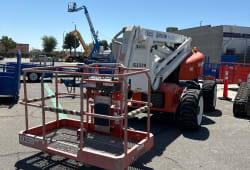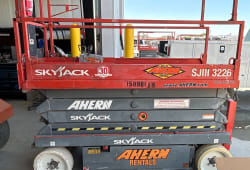Exploring the History of the Pettibone Corporation
9 Lectura mínima
)
junio 30, 2023
The Pettibone Corporation is a pioneering company that has made a significant impact on the industrial landscape, particularly in the fields of construction and infrastructure. This article will delve into the rich history of this innovative corporation and explore its legacy of pioneering technologies, innovations, and industry impact.
The Founding of Pettibone Corporation
At the turn of the 20th century, the Pettibone family legacy began when George G. Pettibone Sr. and his brother formed the industry original Pettibone Bros Manufacturing Company in 1881 by James Pettibone in Chicago, Illinois. They began producing railway car fixtures, which became a huge success. In 1904, Pettibone Bros added a line of industrial lift trucks to their product offerings, which paved the way for the Pettibone Corporation.
The Pettibone Family Legacy
The Pettibone family has a long and storied history in engineering and manufacturing. George G. Pettibone Sr. was a pioneer in the industry, and his legacy has been carried on by his descendants. The company was founded on the principles of quality, innovation, and customer satisfaction, which still guide the corporation today. The Pettibone family has always been committed to excellence, and their dedication to their craft is evident in the products they produce.
Throughout the years, the Pettibone family has built a reputation as a respected and highly esteemed force in the industrial world. Their commitment to quality and innovation has made them a leader in the industry, and their products are used by businesses and organizations around the world.
Early Years and Initial Products
The Pettibone Corporation began with the production of industrial lift trucks, which quickly became known for their high quality and reliability. The company expanded its offerings to include material handling equipment, including conveyor systems, cranes, and hoists. Pettibone products were known for their durability and ability to withstand harsh industrial environments.
As the company grew, Pettibone began to develop specialized equipment for the construction industry. The introduction of the first telescopic boom crane in the country in 1957 was a milestone in the company's history and helped to establish Pettibone as a leading innovator in the industry.
Today, Pettibone continues to innovate and develop new applications and products to meet the needs of their customers. Their commitment to quality and innovation has made them a leader in the industry, and their products are used by businesses and organizations around the world.
From their humble beginnings in railway car fixtures to their current status as a global leader in industrial manufacturing, the Pettibone family legacy continues to thrive. Their commitment to excellence and dedication to their craft has made them a respected and highly esteemed force in the industry, and their products are a testament to their unwavering commitment to quality and innovation.
Expansion and Diversification
Pettibone Mulliken's success in the construction industry led to further expansion and diversification. In the 1970s, the company began to explore opportunities in the heavy equipment market. Pettibone acquired numerous companies and formed partnerships to expand its product offerings and global reach. Pettibone Mulliken, an industry original manufacturer, made reliable forestry and railroad materials with stability that helped to increase productivity.
The Introduction of Material Handling Equipment
:format(webp))
With the introduction of heavy equipment, Pettibone became a leading supplier of excavators, backhoes, loaders, and other heavy machinery. The company's commitment to quality and innovative material handling equipment has helped to establish Pettibone as a prominent player in the heavy equipment market.
One of the key factors that contributed to Pettibone's success in the heavy equipment market was its ability to anticipate the needs of its customers. The company invested heavily in research and development and worked closely with its customers to understand their specific needs and requirements. This approach allowed Pettibone Corp to develop innovative products that were tailored to the needs of its customers and helped the company to stay ahead of the competition.
Acquisitions and Partnerships
Pettibone continued to expand its reach through strategic acquisitions and partnerships. In 1975, the company acquired the Michigan Power Shovel Company, which further expanded Pettibone's reach in the heavy equipment market. The acquisition gave Pettibone access to a range of new products and technologies and helped the company to strengthen its position in the market.
In addition to acquisitions, Pettibone also formed partnerships with other companies to expand its product offerings. One of the most significant partnerships is Pettibone Corp was with the Italian company, JCB. The partnership allowed Pettibone to manufacture and distribute JCB's construction equipment in the United States and Canada and helped the company to expand its product line and reach new customers.
Global Reach and Influence
As Pettibone's reach extended beyond North America, the company became a global force in the industry. The company established manufacturing facilities in Europe and Asia and formed partnerships with companies in South America and Africa. Pettibone's global reach helped to establish the company as a leading manufacturer and supplier of heavy equipment and construction machinery around the world.
One of the keys to Pettibone's success in the global market was its ability to adapt to local market conditions. The company recognized that different regions had different needs and requirements, and worked closely with its local partners to develop products that were tailored to the needs of each market. This approach allowed Pettibone to establish a strong presence in each region and helped the company to build a global reputation for quality and innovation.
In conclusion, Pettibone's expansion and diversification into the heavy equipment market was key factor in the company's success. Through strategic acquisitions and partnerships, the company was able to expand its product offerings and global reach and establish itself as a leading supplier of heavy equipment and construction machinery around the world.
Innovations and Industry Impact
Pettibone has made many significant contributions to the construction and infrastructure industries over the years. The company's innovative technologies have helped to shape the industry and transform the way that work is done.
Pioneering Technologies
Pettibone has been at the forefront of many technological advancements in the industry. One of the company's most significant innovations was the introduction of the first telescopic boom crane in 1957. This revolutionary machine transformed the way that heavy materials could be lifted and transported on construction sites and paved the way for many other types of specialized equipment.
Since then, Pettibone has continued to innovate and improve upon their equipment, developing new technologies such as the Load Lifter and the Cary-Lift. The Load Lifter is a versatile forklift that can handle heavy loads and operate in tight spaces, while the Cary-Lift is a specialized machine designed for moving large pipes and other cylindrical objects.
Contributions to Construction and Infrastructure
Pettibone's innovative equipment has played a significant role in the construction and infrastructure industries. Their heavy machinery has been used in countless construction, mining, forestry, and material handling projects. Pettibone's commitment to quality and reliability has helped to build many of the world's most impressive structures and infrastructure.
For example, Pettibone equipment was used in the construction of the Burj Khalifa, the tallest building in the world. The company's cranes and forklifts were essential in lifting and transporting the massive steel and concrete components that make up the building's structure.
In addition to building towering skyscrapers, Pettibone equipment has been used in the construction of bridges, tunnels, dams, and other critical infrastructure projects. Their machines have helped to dig tunnels, pour concrete, and move heavy materials, making these projects possible.
Environmental and Safety Initiatives
Pettibone is committed to promoting sustainability and safety in the construction and infrastructure maintenance industries. The company has implemented numerous environmental initiatives to reduce its impact on the environment and has also developed safety features and protocols to ensure the well-being of workers and equipment operators.
One of Pettibone's most significant environmental initiatives is its focus on reducing emissions from its plant and equipment. The company has developed a range of low-emission engines and has also implemented hybrid and electric power options for some of its machines. In addition to reducing emissions, Pettibone has also implemented safety features such as anti-tip technology, backup cameras, and automatic shut-off switches. These features help to keep workers and equipment operators safe on job sites.
Overall, Pettibone's innovative and reliable technologies, contributions to construction and infrastructure, and commitment to sustainability and safety have made the company a leader in the industry. Their machines have helped to build some of the world's most impressive structures and infrastructure, and their dedication to environmental and safety initiatives ensures that they will continue to be a driving force in the industry for years to come.
Challenges and ObstaclesLike all companies, Pettibone has faced many challenges and obstacles over the years. Economic downturns, market shifts, and regulatory hurdles have all presented substantial challenges for the company.
Economic Downturns and Market Shifts
The construction industry is notoriously cyclical, and Pettibone has experienced its share of economic downturns and market shifts. The 2008 financial crisis caused significant upheaval in the industry, forcing the company to adapt to a rapidly changing job market.
Competition and Industry Changes
Competition is fierce in the heavy equipment and construction industries, and Pettibone has faced many challenges from competitors over the years. Technological advancements and changes in buyer behavior have also had a significant impact on the industry, forcing the company to constantly adapt and innovate.
Legal and Regulatory Hurdles
The heavy equipment and construction industries are subject to numerous legal and regulatory requirements, which can present significant hurdles for companies like Pettibone. The company has had to navigate complex regulatory frameworks and legal challenges to remain compliant and competitive.
The Legacy of the Pettibone Corporation
Despite the challenges and obstacles the company has faced, Pettibone has remained a leading force in the industrial landscape. The company's commitment to innovation, quality, and customer satisfaction has helped to establish its lasting legacy as a pioneer in the industry, and a prominent player on the global stage.

Caleb Woods is an experienced content specialist and an editor at Boom & Bucket, blending his journalism background with expertise in the heavy equipment industry. He delivers engaging, informative content to help professionals stay informed and make smarter decisions in the machinery market.











